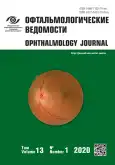Cataract surgery in pseudoexfoliation syndrome
- Authors: Potyomkin V.V.1,2, Goltsman E.V.2
-
Affiliations:
- Academican I.P. Pavlov First St. Petersburg State Medical University
- City Ophthalmologic Center of City Hospital No. 2
- Issue: Vol 13, No 1 (2020)
- Pages: 37-42
- Section: Original study articles
- URL: https://journals.rcsi.science/ov/article/view/25739
- DOI: https://doi.org/10.17816/OV25739
- ID: 25739
Cite item
Abstract
Phacoemulsification is a main method of cataract surgery. The presence of pseudoexfoliation syndrome (PEX) may involve the procedure in difficulty and contribute to development of intra- and postoperative complications.
Purpose. To assess the effect of PEX on phacoemulsification.
Materials and methods. 1010 patients (580 with PEX and 430 without PEX) admitted for cataract surgery, underwent phacoemulsification with implantation of various IOL types. An analysis of main phacoemulsification parameters was carried out: cumulative dissipated energy (CDE), aspirated BSS amount, time of surgery. The prevalence of some possible intraoperative complications was assessed: descemet membrane detachment, posterior capsule rupture, retrolental lens material, and zonular dialysis.
Results. In patients with PEХ, local descemet membrane detachment and retrolental lens material were significantly more common, at the same time CDE was higher.
Conclusion. When planning phacoemulsification, patients with PEX require more thorough preoperative examination, higher alertness during surgery and longer follow-up in the postoperative period.
Full Text
##article.viewOnOriginalSite##About the authors
Vitaly V. Potyomkin
Academican I.P. Pavlov First St. Petersburg State Medical University; City Ophthalmologic Center of City Hospital No. 2
Email: potem@inbox.ru
PhD, Assistant Professor, Department of Ophthalmology; Ophthalmologist
Russian Federation, Saint PetersburgElena V. Goltsman
City Ophthalmologic Center of City Hospital No. 2
Author for correspondence.
Email: ageeva_elena@inbox.ru
ophthalmologist
Russian Federation, Saint PetersburgReferences
- Bourne RR, Stevens GA, White RA, et al. Causes of vision loss worldwide, 1990-2010: a systematic analysis. Lancet. 2013;1(6): e339-e349. https://doi.org/10.1016/S2214-109X(13)70113-X.
- Kanthan GL, Mitchell P, Burlutsky G, et al. Pseudoexfoliation syndrome and the long-term incidence of cataract surgery: the Blue Mountains eye study. Am J Ophthalmol. 2013;155(1):83-88.e1. https://doi.org/10.1016/j.ajo.2012.07.002.
- Ekström C, Botling Taube A. Pseudoexfoliation and cataract surgery: a population-based 30-year follow-up study. Acta Ophthalmol. 2015;93(8):774-777. https://doi.org/10.1111/aos.12789.
- Schöltzer-Schrehardt U. Pseudoexfoliation syndrome: the puzzle continues. J Ophthalmic Vis Res. 2012;7(3):187-189.
- Conway RM, Schöltzer-Schrehardt U, Küchle M, Naumann GO. Pseudoexfoliation syndrome: pathological manifestations of relevance to intraocular surgery. Cin Exp Ophthalmol. 2004;32(2): 199-210. https://doi.org/10.1111/j.1442-9071.2004.00806.x.
- Schöltzer-Schrehardt UM, Koca MR, Naumann GO, Volkholz H. Pseudoexfoliation syndrome. Ocular manifestation of a systemic disorder? Arch Ophthalmol. 1992;110(12):1752-1756. https://doi.org/10.1001/archopht.1992.01080240092038.
- Vazquez-Ferreiro P, Carrera-Hueso FJ, Poquet Jornet JE, et al. Intraoperative complications of phacoemulsification in pseudoexfoliation: meta-analysis. J Cataract Refract Surg. 2016;42(11): 1666-1675. https://doi.org/10.1016/j.jcrs.2016.09.010.
- Bencić G, Zorić-Geber M, Sarić D, et al. Clinical importance of the lens opacities classification system III (LOCS III) in phacoemulsification. Coll Antropol. 2005;29(Suppl 1):91-94.
- Потёмкин В.В., Агеева Е.В. Нестабильность связочного аппарата хрусталика у пациентов с псевдоэксфолиативным синдромом: анализ 1000 последовательных факоэмульсификаций // Офтальмологические ведомости. – 2018. – Т. 11. – № 1. – С. 41–46. [Potyomkin VV, Ageeva EV. Zonular instability in patients with pseudoexfoliative syndrome: the analysis of 1000 consecutive phacoemulsifications. Ophthalmology journal. 2018;11(1):41-46. (In Russ.)]. https://doi.org/10.17816/OV11141-46.
- Hashemi H, Seyedian MA, Mohammadpour M. Small pupil and cataract surgery. Curr Opin Ophthalmol. 2015;26(1):3-9. https://doi.org/10.1097/ICU.0000000000000116.
- Bayractar S, Altan T, Kucuksumer Y, Yilmaz OF. Capsular tension ring implantation after capsulorhexis in phacoemulsification of cataracts associated pseudoexfoliation syndrome; intraoperative complications and early postoperative findings. J Cataract Refract Surg. 2001;27(10):1620-1628. https://doi.org/10.1016/s0886-3350(01)00965-8.
- Jacob S, Agarwal A, Agarwal A, et al. Efficacy of a capsular tension ring for phacoemulsification in eyes with zonular dialysis. J Cataract Refract Surg. 2003;29(2):315-321. https://doi.org/10.1016/s0886-3350(02)01534-1.
- Küchle M, Viestenz A, Martus P, et al. Anterior chamber depth and complications during cataract surgery in eyes with pseudoexfoliation syndrome. Am J Ophthalmol. 2000;129(3):281-285. https://doi.org/10.1016/s0002-9394(99)00365-7.
- Jehan FS, Mamalis N, Crandall AS. Spontaneous late dislocation of intraocular lens within the capsular bag in pseudoexfoliation patients. Ophthalmology. 2001;108(10):1727-1731. https://doi.org/10.1016/s0161-6420(01)00710-2.
- Kaštelan S, Bušic M. Pseudoexfoliation syndrome and cataract surgery. Ophthalmologia Croatica. 2003;11:37-40.
- Freissler K, Küchle M, Naumann GO. Spontaneous dislocation of the lens in pseudoexfoliation syndrome. Arch Ophthalmol. 1995;113(9):1095-1096. https://doi.org/10.1001/archopht. 1995.01100090017008.
- Naumann GO, Küchle M, Schönherr U. [Pseudo-exfoliation syndrome as a risk factor for vitreous loss in extra-capsular cataract extraction. The Erlangen eye information group. (In German.)]. Fortschr Ophthalmol. 1989;86(6):543-545.
- Schlötzer-Schrehardt U, Naumann GO. A histopathologic study of zonular instability in pseudoexfoliation syndrome. Am J Ophthalmol. 1994;118(6):730-743. https://doi.org/10.1016/s0002-9394(14)72552-8.
- Busić M, Kastelan S. Pseudoexfoliation syndrome and cataract surgery by phacoemulsification. Coll Antropol. 2005;29(Suppl 1): 163-166.
- Malyugin B. Small pupil phaco surgery: a new technique. Ann Ophthalmol (Skokie). 2007;39(3):185-193. https://doi.org/10.1007/s12009-007-0023-8.
Supplementary files







